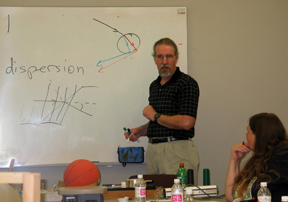 |
Glenn Sowell, Ph.D., physics professor from the University of Nebraska at Omaha, discusses the science of light with elementary school teachers. The teachers participated in UNMC’s four-day workshop on how to improve the science curriculum in their classroom. Listening to Dr. Sowell is fourth-grade teacher Joann Lewis. |
In fact, the complexities of how a convergent lens works can be explained simply by using a Styrofoam cup, a penny and a plastic baggie, said the physics professor from the University of Nebraska at Omaha.
“Take the cup, put a penny in the bottom, cover the top with the plastic baggie, secure it with a rubber band, but leave it loose enough so that it will hold a little water and you have a converging lens,” Dr. Sowell said. “And when your students look down into the cup through the water the image of the penny is magnified.”
“Oh, that’s easy,” one teacher said.
“And inexpensive,” another teacher responded.
Dr. Sowell and the teachers were at UNMC for a Science Education Partnership Award (SEPA) workshop held June 19-22.
The four-day workshop is part of the $1.3 million SEPA grant Maurice Godfrey, Ph.D., principal investigator and associate professor of pediatrics at UNMC, and co-investigator Roxanna Jokela, director of the Rural Health Education Network at UNMC, obtained earlier this year with the intention of strengthening the science curriculum of American Indian youths on reservations in Nebraska and South Dakota.
All of the elementary school teachers attending the workshop teach American Indian youths and most teach at schools on a reservation.
SEPA grants are designed to improve life science literacy, bring together biomedical and behavioral researchers, educators, community groups, and other interested organizations in partnerships to create and disseminate programs that give K-12 students and their teachers a better understanding of life sciences.
“The long-term goals of this project are to promote student interest in the health sciences, foster a more science literate public and ultimately increase the number of Native Americans entering health careers,” Dr. Godfrey said.
The summer workshop is intended to help the teachers develop health science education modules that are age-appropriate for classroom use.
“I’d like to develop a stronger interest in science among my students,” said Joann Lewis, who teaches fourth grade at Umonhon Nation Public School on the Omaha Indian Reservation in northeastern Nebraska.
“There are lots of simple ideas that are easily applied in the classroom and don’t cost a lot of money to recreate,” Lewis said. “I’m so excited, I can’t wait to go back and use what I’ve learned.”